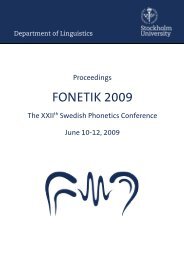The Double Passive in Swedish - Institutionen för lingvistik ...
The Double Passive in Swedish - Institutionen för lingvistik ...
The Double Passive in Swedish - Institutionen för lingvistik ...
You also want an ePaper? Increase the reach of your titles
YUMPU automatically turns print PDFs into web optimized ePapers that Google loves.
(32) Hon älskar/slutar/avser/beslutar/diskuterar/ämnar/accepterar att spela schack.<br />
She loves/stops/<strong>in</strong>tends/decides/discusses/aims/accepts to play chess<br />
In SAG 3 (1999:573) an overview of the lexical context of <strong>in</strong>f<strong>in</strong>itival complements (as<br />
object/XCOMP) is given, arranged and sorted semantically. In category 1-4 the character of auxiliary<br />
verbs is strong, and <strong>in</strong> the latter almost non-existent. Verbs where a follow<strong>in</strong>g complementizer is<br />
considered be<strong>in</strong>g as good as impossible is marked “–“, and the correspond<strong>in</strong>g verbs (where the<br />
complementizer is considered close to obligatory or obligatory) is marked “+”. A limited number of<br />
examples of verbs <strong>in</strong> the sort<strong>in</strong>g below are shown. Some of the verbs may occur <strong>in</strong> several groups:<br />
1. Epistemic verbs: ‘behöva’– (‘need’), ‘lär’– (‘may’).<br />
2. Deontic verbs: ‘borde’– (‘aught’), ‘måste’– (‘must’).<br />
3. Actional verbs: ‘börja’– (‘start’), ‘fortsätta’– (‘cont<strong>in</strong>ue’).<br />
4. Verbs determ<strong>in</strong><strong>in</strong>g the <strong>in</strong>gressive art of action at the <strong>in</strong>f<strong>in</strong>itival complement: ‘få’–<br />
(se) (‘get (to see)’).<br />
5. Intentional verbs: ‘planera’+ (‘plan’), ‘beluta’+ (‘decide’), ‘hota’+ (‘threaten’),<br />
‘avse’+ (‘<strong>in</strong>tend’).<br />
6. Dynamic verbs: ‘<strong>för</strong>må’– (‘<strong>in</strong>duce’), ‘<strong>för</strong>tjäna’+ (deserve).<br />
7. Verbs determ<strong>in</strong><strong>in</strong>g the subject referents fear, expectation etc. of an action to occur:<br />
‘frukta’+ (‘fear’), ‘vänta’+ (expect’).<br />
8. Verbs determ<strong>in</strong><strong>in</strong>g the subject referents valuation of the action: ‘hata’+’ (‘hate’),<br />
‘gilla’+ (‘like’).<br />
9. Verbs determ<strong>in</strong><strong>in</strong>g the subject referents <strong>in</strong>itiative or omission to execute the action:<br />
‘<strong>för</strong>söka’+ (‘try’), ‘undvika’+ (‘avoid’).<br />
In a corpus study 15 of the use of “bare” <strong>in</strong>f<strong>in</strong>itival complements (no complementizer) <strong>in</strong> <strong>Swedish</strong>,<br />
Lagerwall (1999) confirmed the lack of a complementizer similar to (31). <strong>The</strong> total frequency of bare<br />
<strong>in</strong>f<strong>in</strong>itives was over 99 % regard<strong>in</strong>g the auxiliar modals such as ‘böra’ (‘need’), ‘kunna’ (‘need’),<br />
‘måste’ (‘must’), ‘må’ (‘may’), ‘lär’ (‘will’) etc. Regard<strong>in</strong>g “modal-like” verbs (i.e. equi verbs and<br />
perhaps some rais<strong>in</strong>g verbs), the use of the complementizer showed a vary<strong>in</strong>g occurrence depend<strong>in</strong>g<br />
on the verb.<br />
Lagerwall (1999:6) discusses possible diachronic connections and refers to Mjölberg’s work.<br />
Mjölberg (1950:71) argues that especially two verb groups that occur with bare <strong>in</strong>f<strong>in</strong>itives, appear to<br />
be <strong>in</strong> different stages of a development – toward the exclusion of a complementizer. Accord<strong>in</strong>g to<br />
15 <strong>The</strong> corpus study was achieved us<strong>in</strong>g the corpus PAROLE conta<strong>in</strong><strong>in</strong>g approx. 25 million tokens.<br />
24

















